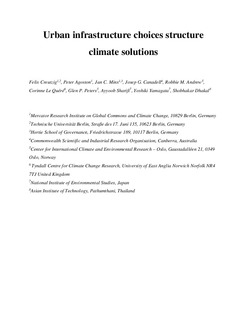| dc.contributor.author | Creutzig, Felix | |
| dc.contributor.author | Agoston, Peter | |
| dc.contributor.author | Minx, Jan C | |
| dc.contributor.author | Canadell, Josep G. | |
| dc.contributor.author | Andrew, Robbie | |
| dc.contributor.author | Le Quéré, Corinne | |
| dc.contributor.author | Peters, Glen Philip | |
| dc.contributor.author | Sharifi, Ayyoob | |
| dc.contributor.author | Yamagata, Yyoshiki | |
| dc.contributor.author | Dhakal, Shobhakar | |
| dc.date.accessioned | 2018-02-12T11:37:34Z | |
| dc.date.available | 2018-02-12T11:37:34Z | |
| dc.date.created | 2016-11-30T22:05:10Z | |
| dc.date.issued | 2016 | |
| dc.identifier.citation | Nature Climate Change. 2016, 6 1054-1056. | |
| dc.identifier.issn | 1758-678X | |
| dc.identifier.uri | http://hdl.handle.net/11250/2484051 | |
| dc.description.abstract | Cities are becoming increasingly important in combatting climate change, but their overall role in global solution pathways remains unclear. Here we suggest structuring urban climate solutions along the use of existing and newly built infrastructures, providing estimates of the mitigation potential | |
| dc.language.iso | eng | |
| dc.title | Urban infrastructure choices structure climate solutions | |
| dc.type | Peer reviewed | |
| dc.type | Journal article | |
| dc.description.version | acceptedVersion | |
| dc.source.pagenumber | 1054-1056 | |
| dc.source.volume | 6 | |
| dc.source.journal | Nature Climate Change | |
| dc.identifier.doi | 10.1038/nclimate3169 | |
| dc.identifier.cristin | 1406825 | |
| dc.relation.project | Norges forskningsråd: 259665 | |
| dc.relation.project | Norges forskningsråd: 209701 | |
| cristin.unitcode | 7475,0,0,0 | |
| cristin.unitname | CICERO Senter for klimaforskning | |
| cristin.ispublished | true | |
| cristin.fulltext | postprint | |
| cristin.qualitycode | 2 | |
